
Agriculture plays a vital role in Indian economy.India ranks second worldwide in farm outputs.Though crops are facing problem like pests, climate change, soil erosion, diseases water scarcity and this led to a great loss.Farmers who are able to diagnose these diseases are able to take actions on it.But for farmers who are not able to identity take improper actions.This destroys all the crops.At last we see there is huge loss of time, money and labour. Analysing the problem which farmers have been facing of years, we needed to come up with solution in which human interaction is minimal.Smart farming have already made its place in the society, to add to that we have come up with this improvised smart farming technique.Smart Farming Stick (SFS) by using these techniques our system will work as a guide, to assist the farmers by giving information.Farming is about risk calculation – But what if the risk can be calculated and cured beforehand.Analysis can help you with identifying the weakness and strength of the soil, resulting in more revenue generation and saving ample amount of time. Automated solutions and technology offer greater accuracy based on more efficient data collection and monitoring.
Demo Video
Project Proposal
1. High-level project introduction and performance expectation
Farmers all over the world require advanced technology to help transform their practices into a more sustainable and productive agri-tech process. Real-time soil data has become one of the most valuable resources among farmers. Real-time soil sensor data can be manipulated in manners that increase farm production and profit. Of these sensor systems, only a few are commercially available for monitoring. In this review, these sensors harness the potential to revolutionize decision management systems in agriculture.
Agriculture is an important sector of the Indian economy as it contributes about 17% to the total GDP and provides employment to over 60% of the population. Indian agriculture has registered a massive growth over the last few decades.
Especially in India, Farmer's incomes are very low and efforts have to be made to enhance their incomes. For this, increasing the efficiencies of agricultural production processes and the entire value chain is important. Digital Agriculture is emerging as one of the ways to increase efficiencies and enhance incomes in agriculture globally.
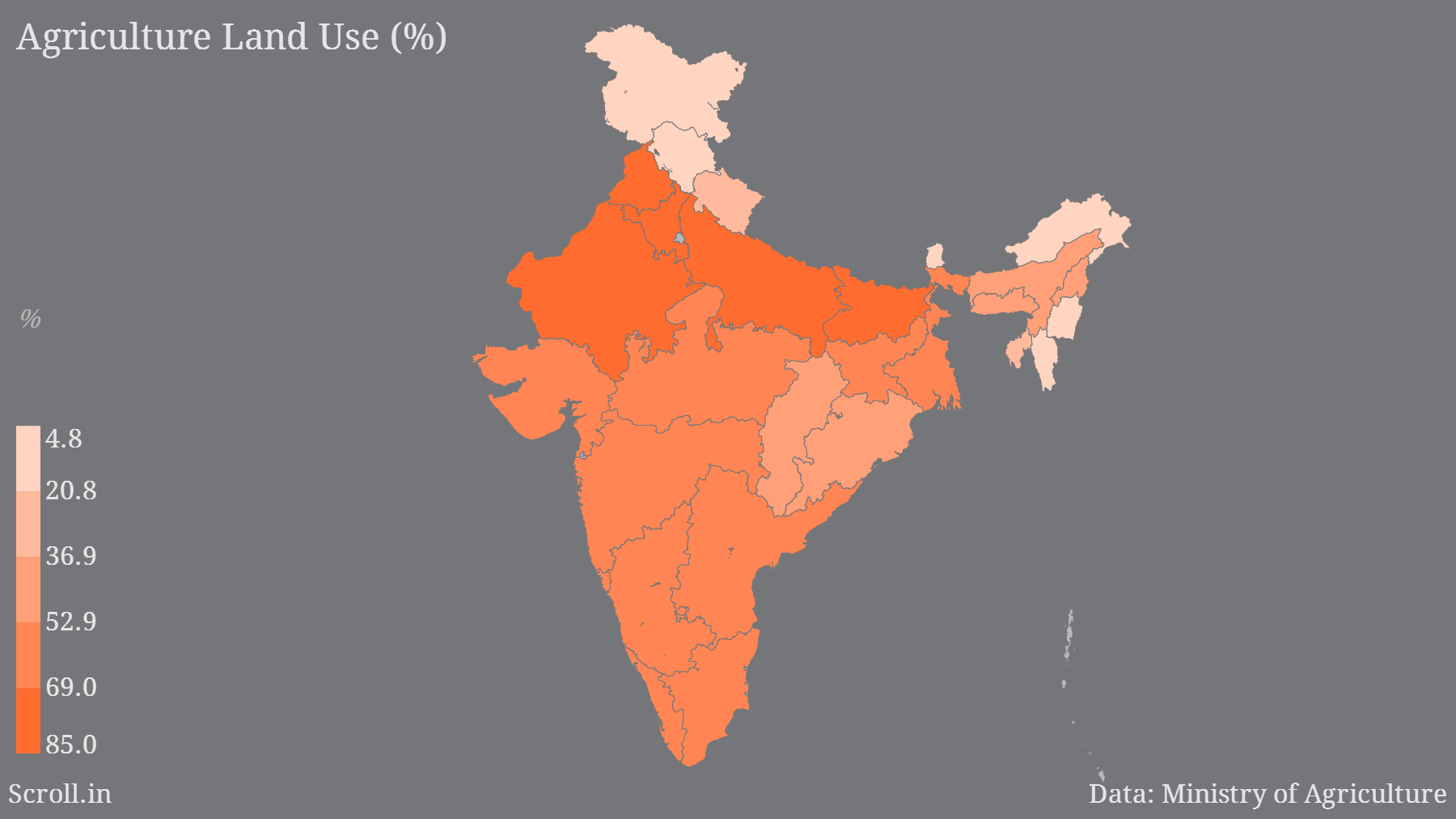
Agricultural commodities produced have to undergo a series of operations such as harvesting, threshing, winnowing, bagging, transportation, storage, processing, and exchange before they reach the market, and as evident from several studies across the country, there are considerable losses in crop output at all these stages.
Crops are facing problems like pests, climate change, soil erosion, diseases water scarcity and this led to a great loss. Farmers who can diagnose these diseases can take action on it. But for farmers who are not able to identify take improper actions thus destroying all the crops. Ultimately resulting in a huge loss of time, money, and labor. Analyzing the problem which farmers have been facing for years, we needed to come up with a solution in which human interaction is minimal. Smart farming has already made its place in society and to add to that, we have come up with an improvised farming technique.
Smart Farming Stick (SFS) by using these techniques our system will work as a guide, to assist the farmers by giving information. Farming is about risk calculation: But what if the risk could be calculated and cured beforehand? Analysis can help you with identifying the weakness and strengths of the soil, resulting in more revenue generation and saving an ample amount of time. Automated solutions and technology offer greater accuracy based on more efficient data collection and monitoring.

2. Block Diagram
Workflow
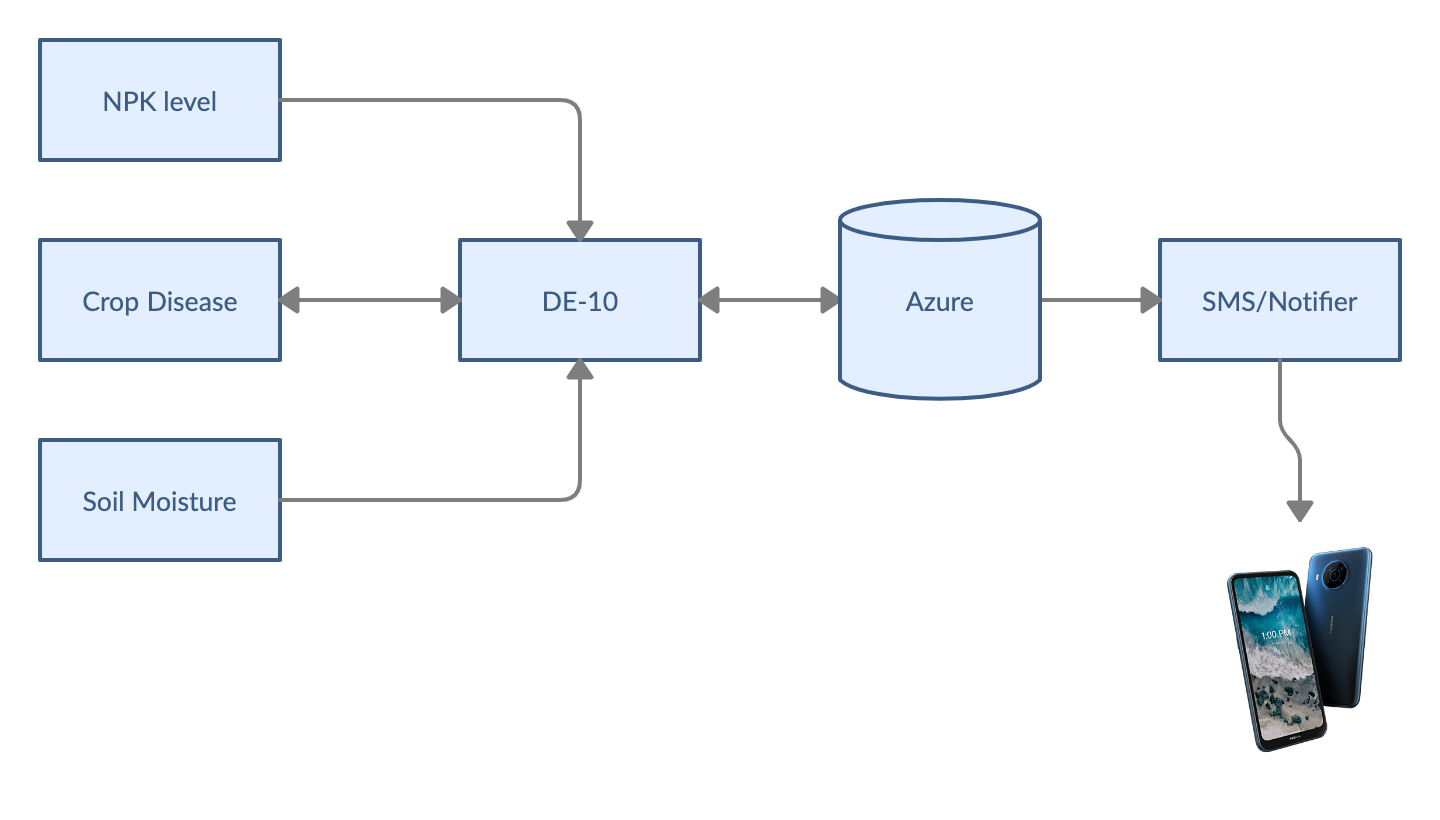
Basic block diagram
1) The DE10 is the mother or the core of the project. All processes are made and taken care of on this board.
2) The webcam is used to acquire image data and analyze pests and diseases in real-time.
3) Humidity and NPK Sensor(s) are used to acquire raw data from the soil and make necessary processes.
3. Expected sustainability results, projected resource savings
Smart Stick not only satisfies the farmers' needs but will also not let compromise the ability of future generations to meet their needs. It also helps other common or growing trends in agriculture, such as family farming(small space plantation, particular varieties, etc), organic farming, and enhances very respected and transparent farming. Smart Farming can also provide great benefits in terms of environmental issues, for example, through more efficient use of water, or optimization of treatments and inputs.
We referred to the below research papers :
a) Security and Privacy in Smart Farming Challenges and Opportunities by Mayank Gupta, Mahmood Abdelsalam, Sajad Khorsandrood, and Sudip Mittal
b) Image processing for Smart Farming by Monika Jhuria, Ashwini Kumar, and Rushikesh Borse
And we will not shy away to proudly tell that this literature has helped form our workflow and even the whole product in a way.
To make our product sustainable and reliable, we have iterated quite a lot to improve its performance like reducing the complexity of the AI model; which we believe has helped it stand out from other existing products.
The modern world is getting dominant by Deep Learning models and fortunately has also played a vital role in our product too.
Reliable, Time, and cost-effective applications can change the expectation of outputs for farmers or any type of end-user if implemented the right way.
4. Design Introduction

The DE-10 Nano is a highly versatile board giving complete control over its components and we have tried to build this product by making use of its parallel processing structure. The board also supports Arduino headers to use and can be implemented in the XFCE system via the HPS and FPGA bridge. Overall, the DE-10 Nano has been a very flexible, fast, and a reliable board for this product.
Our product/project consists of sensors like soil moisture and NPK sensor which is used to collect the data from the soil. A Webcam is mounted on the top of the stick for monitoring the pests and detecting diseases. This Webcam is connected with the HPS interface of the board running an AI model and the sensors are interfaced from the FPGA making complete use of the duality of the DE-10 Nano.
For detecting pests and diseases in realtime, the YOLOv5 Nano model was trained with a custom self-prepared dataset and was deployed on the HPS. The inference example is showcased in our video given below.
APPLICATIONS:
Our smart farming system has a wide range of applications in modern agricultural context.
Some of those are:
1) Soil erosion avoidance
2) Crop quality enrichment
3) Pest mitigation
4) Disease mitigation
5) Process automation
TARGET USERS:
Our target users are those who mainly works on agriculture based work:
1) Farmers
2) Home gardeners
3) Agro researchers
4) Agro firms
5. Functional description and implementation
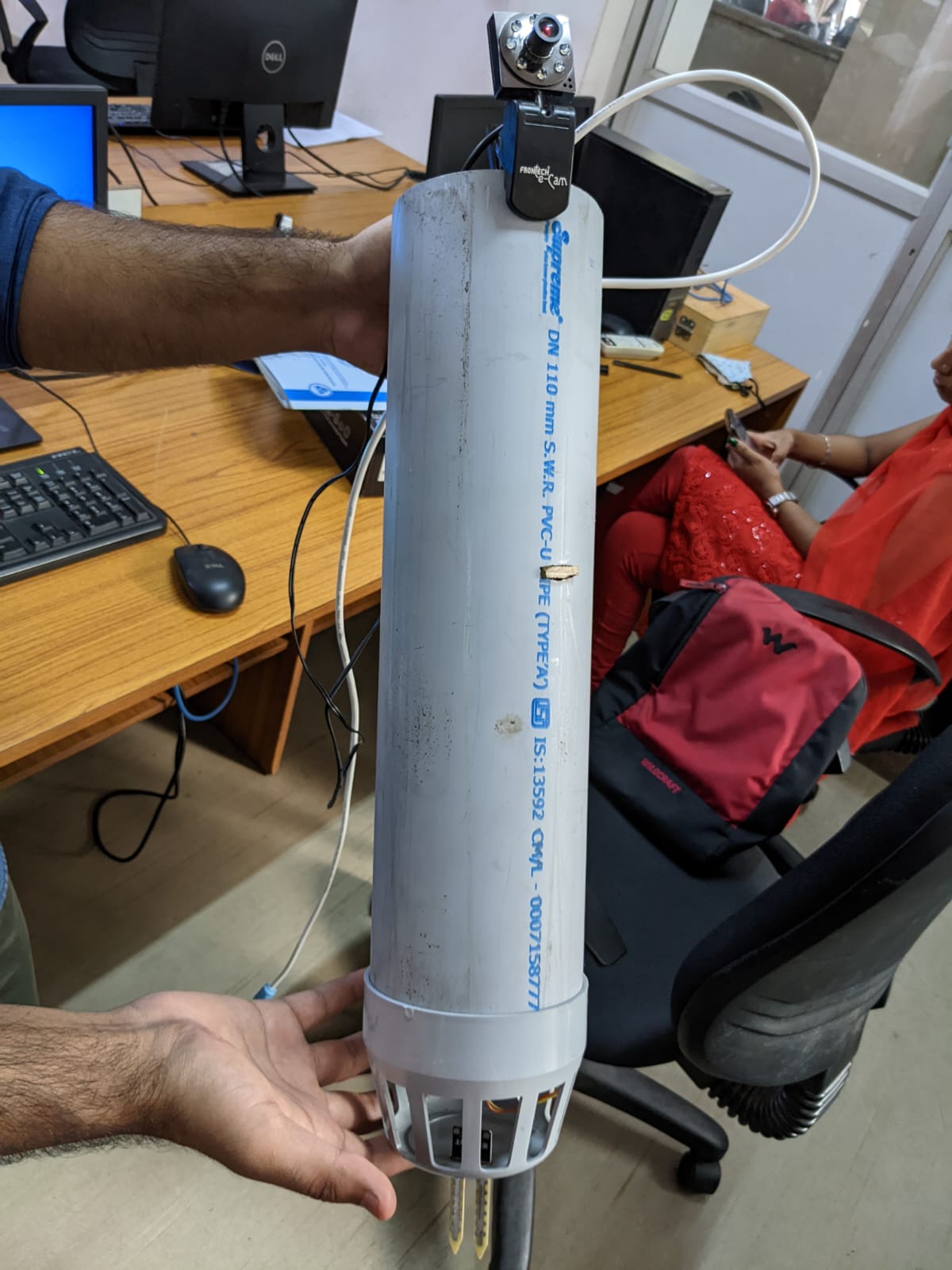
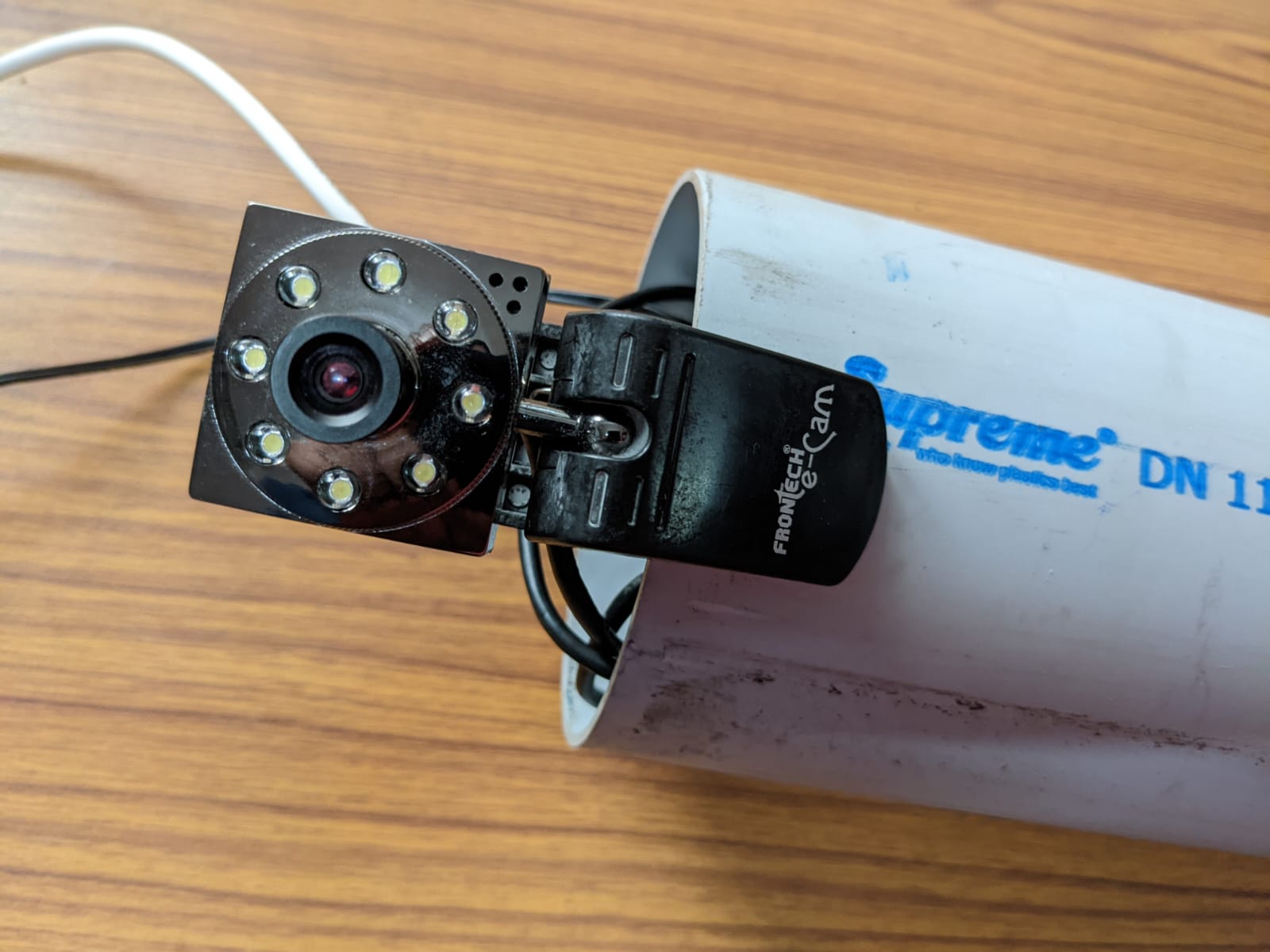
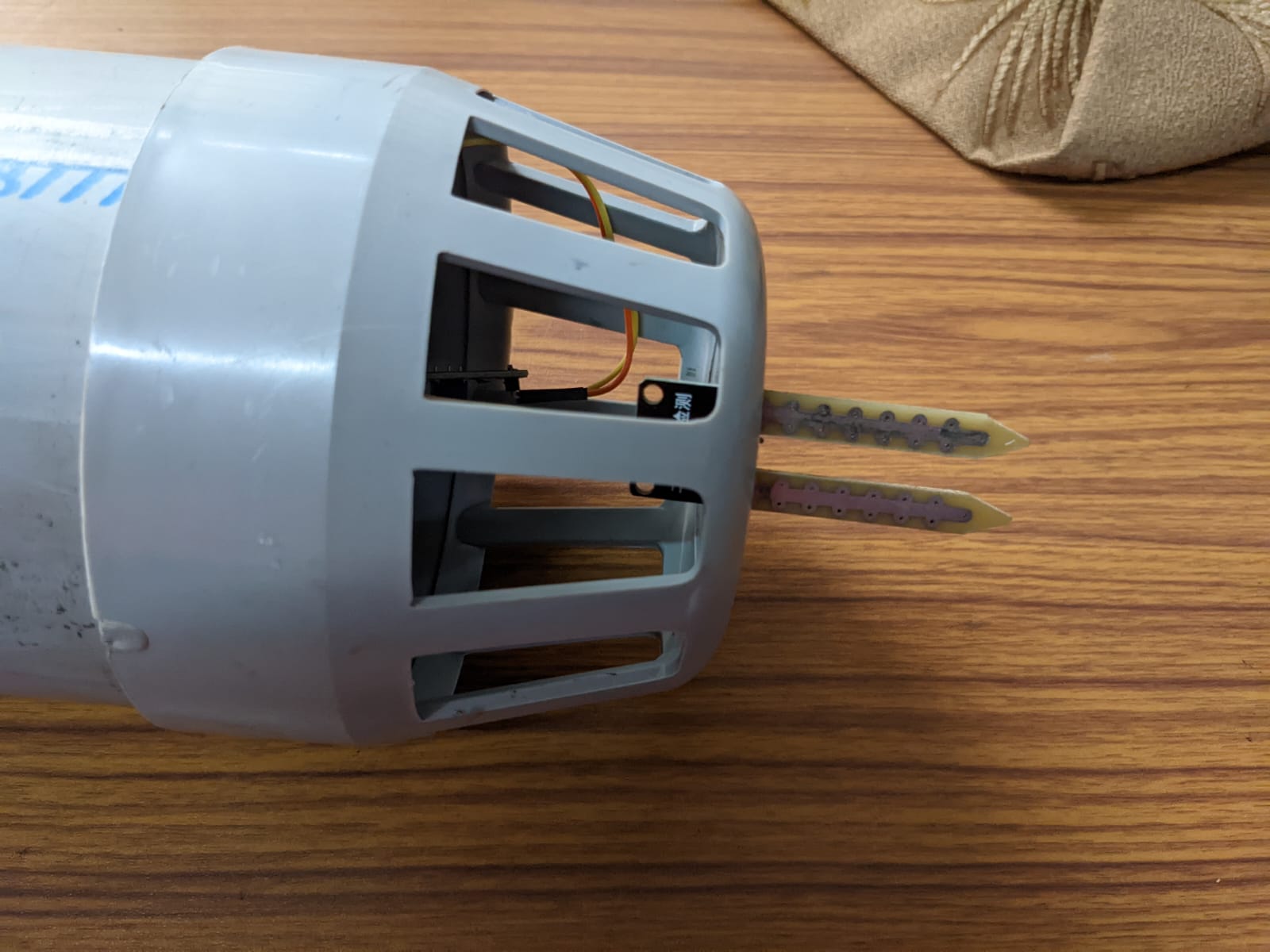
Fig.: The above photographs are from the working prototype of our model - 'Smart Farming Stick' with the Camera and sensor to acquire the raw data
Hardware
Data accumulation by Sensor
The sensors are connected to the FPGA's ADC Pins to acquire direct values of output voltages and then are processed later for further usage. Here, We give the farmer some amount of flexibility and ease by setting different thresholds for different crops, as in, Wetter crops have lower thresholds and drier crops have higher value thresholds. The rationale behind this is that the output voltage decreases as the soil gets wetter.
Soil Moisture Sensor Module Features & Specifications
- Operating voltage: 3.3V~5V
- Dual output mode: Analog output is more accurate
- A fixed bolt hole for easy installation
- With power indicator (red) and digital switching output indicator (green)
- Having an LM393 comparator chip that is stable
- Panel PCB Dimension: Approx.3cm x 1.5cm
- Soil Probe Dimension: Approx. 6cm x 3cm
- Cable Length: Approx. 21cm
- VCC: 3.3V-5V
Software
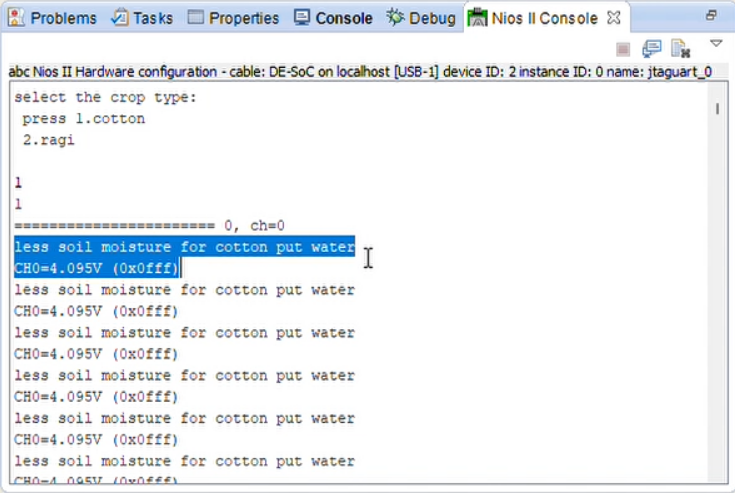 Fig: A picture of the result from Nios II Console
Fig: A picture of the result from Nios II Console
The program is written in C language using Quartus Prime and is deployed on the board where the user is asked to enter the type of crop based on which a threshold is set and is triggered when it is met.
SMS Notification Client
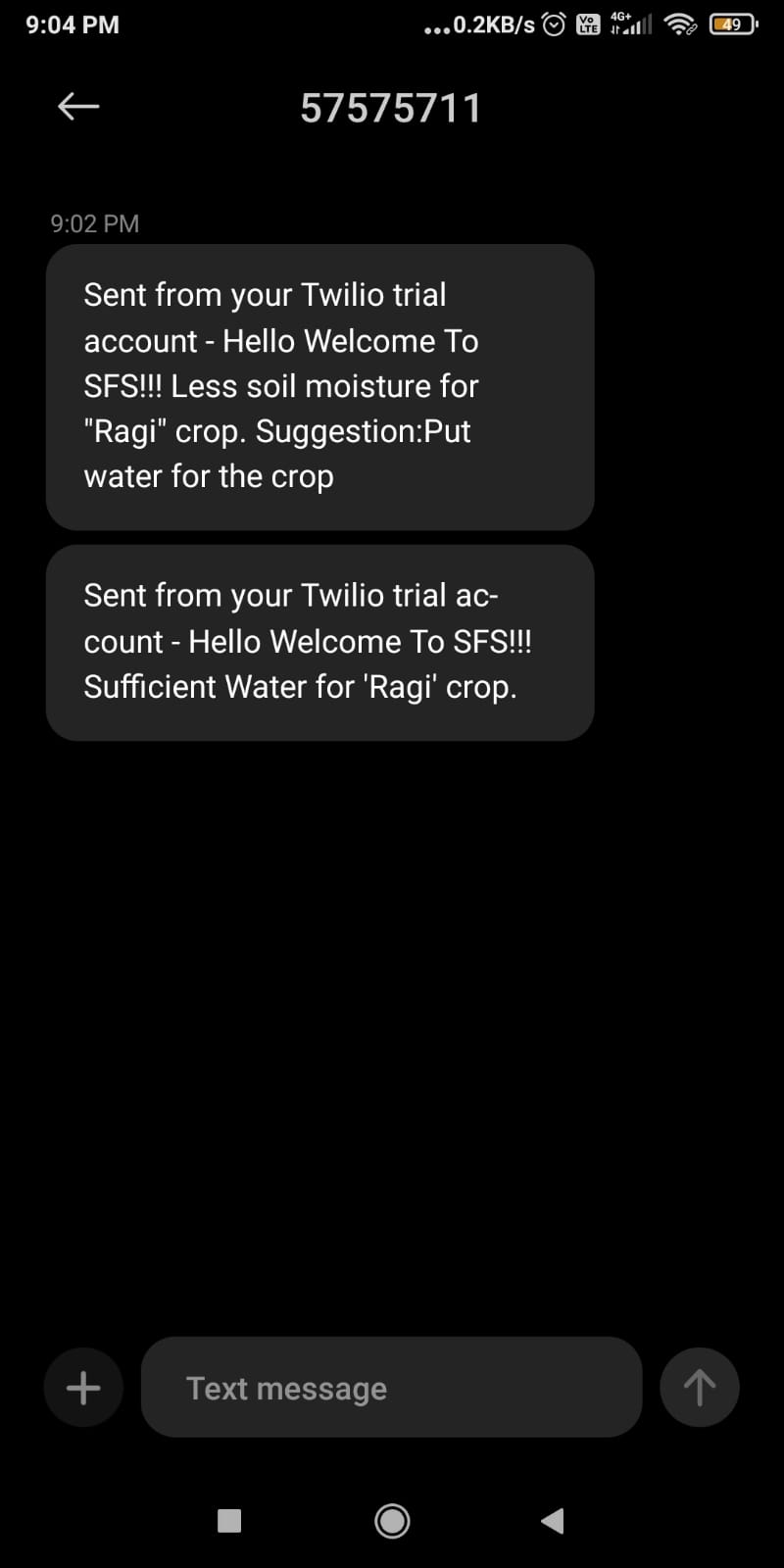
Fig: This screenshot showcases the SMS based notification that arrives on the end-user's mobile phone
The FPGA dumps the text into a text file according to a preset schedule on the server computer and then a python file scrapes the text and uses an SMS client to notify the user/farmer.
6. Performance metrics, performance to expectation
The AI (Object Detection) model
| Model | size (pixels) |
mAPval 0.5:0.95 |
mAPval 0.5 |
Speed CPU b1 (ms) |
Speed V100 b1 (ms) |
Speed V100 b32 (ms) |
params (M) |
FLOPs @640 (B) |
|---|---|---|---|---|---|---|---|---|
| YOLOv5n | 640 | 28.0 | 45.7 | 45 | 6.3 | 0.6 | 1.9 | 4.5 |
| YOLOv5s | 640 | 37.4 | 56.8 | 98 | 6.4 | 0.9 | 7.2 | 16.5 |
This table differentiates between YOLOV5(small) and YOLOv5(nano) based on various factors
The table illustrates clearly that the YOLOv5s(small) model is much more accurate(mAP) than the YOLOv5n(nano) model but due to computational constraints, we could not choose the former for our implementations.
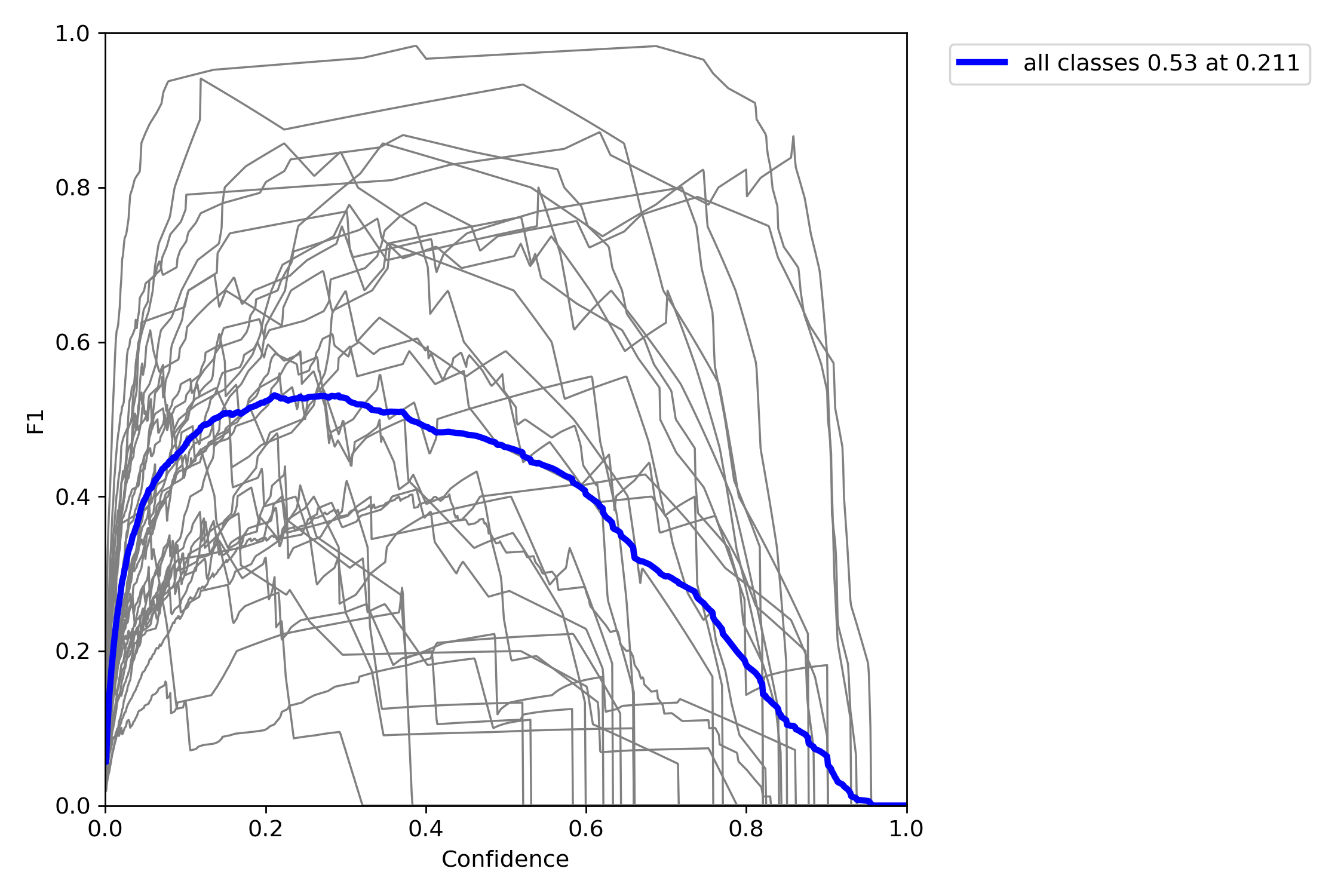 The F1 curve of the YOLOv5nano model
The F1 curve of the YOLOv5nano model
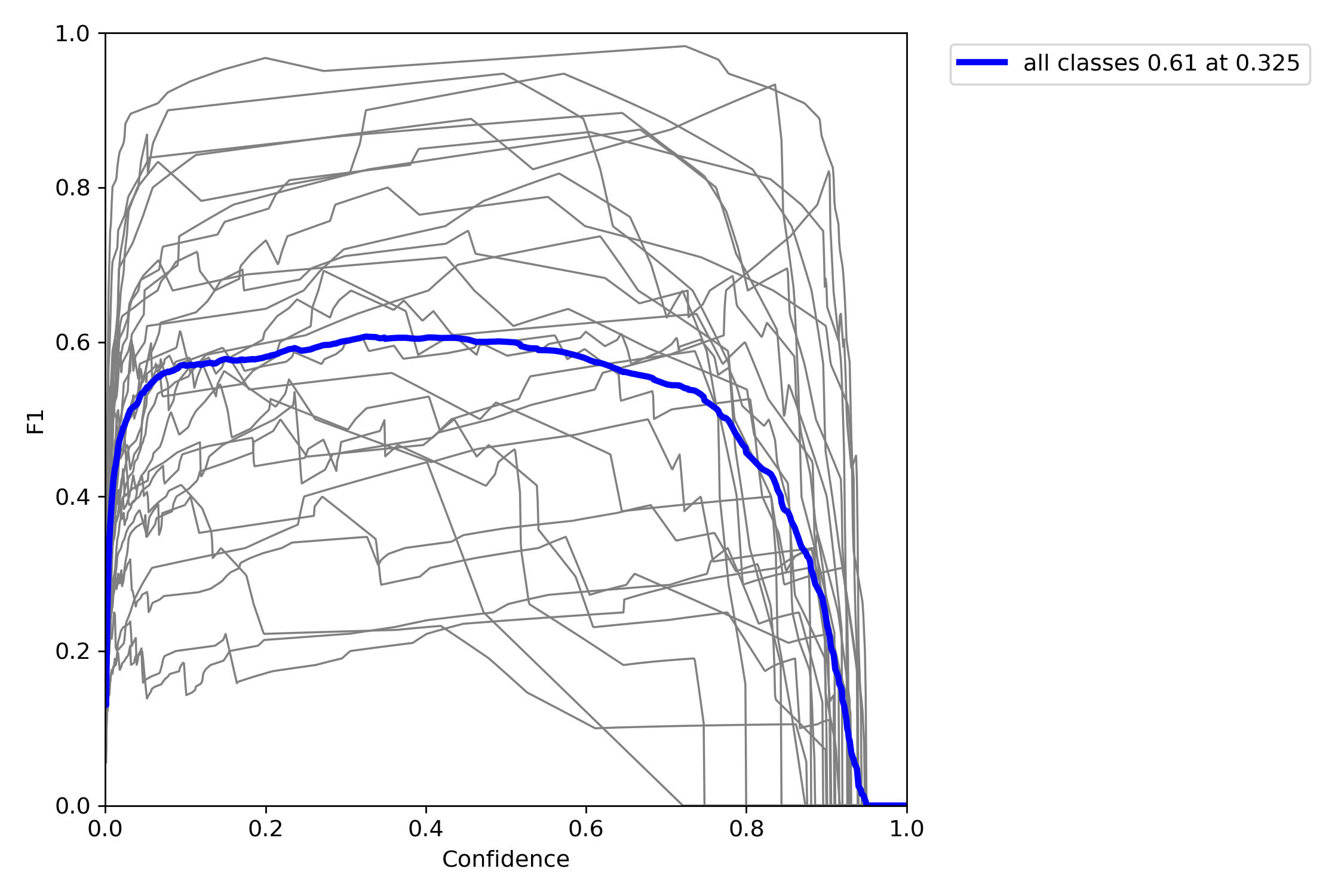
The F1 curve of the YOLOv5small model
The F1 score is a score used to determine the accuracy of a model when the dataset has an unbalanced number of examples in different classes. If observed, the small model achieves a great accuracy of 61% distributed among different classes and sometimes even >90% for classes with a good number of examples like Potato Blight or Tomato Septoria. But, there is a catch. The 'small' model is not only just 8% more accurate than the 'nano' model, it also has almost 3.79 times more parameters(Millions) than the nano model and also requires approximately 3.6 times more Billion FLOPS than the nano model. Therefore, we decided that the usage of the nano model makes a lot more sense due to the above reasons, and the accuracy tradeoff was absolutely worth it.
Thanks to the powerful Dual-Core ARMv9 backed HPS, the implementation of the AI model on the edge was a success.
7. Sustainability results, resource savings achieved
Effort in Sustainability
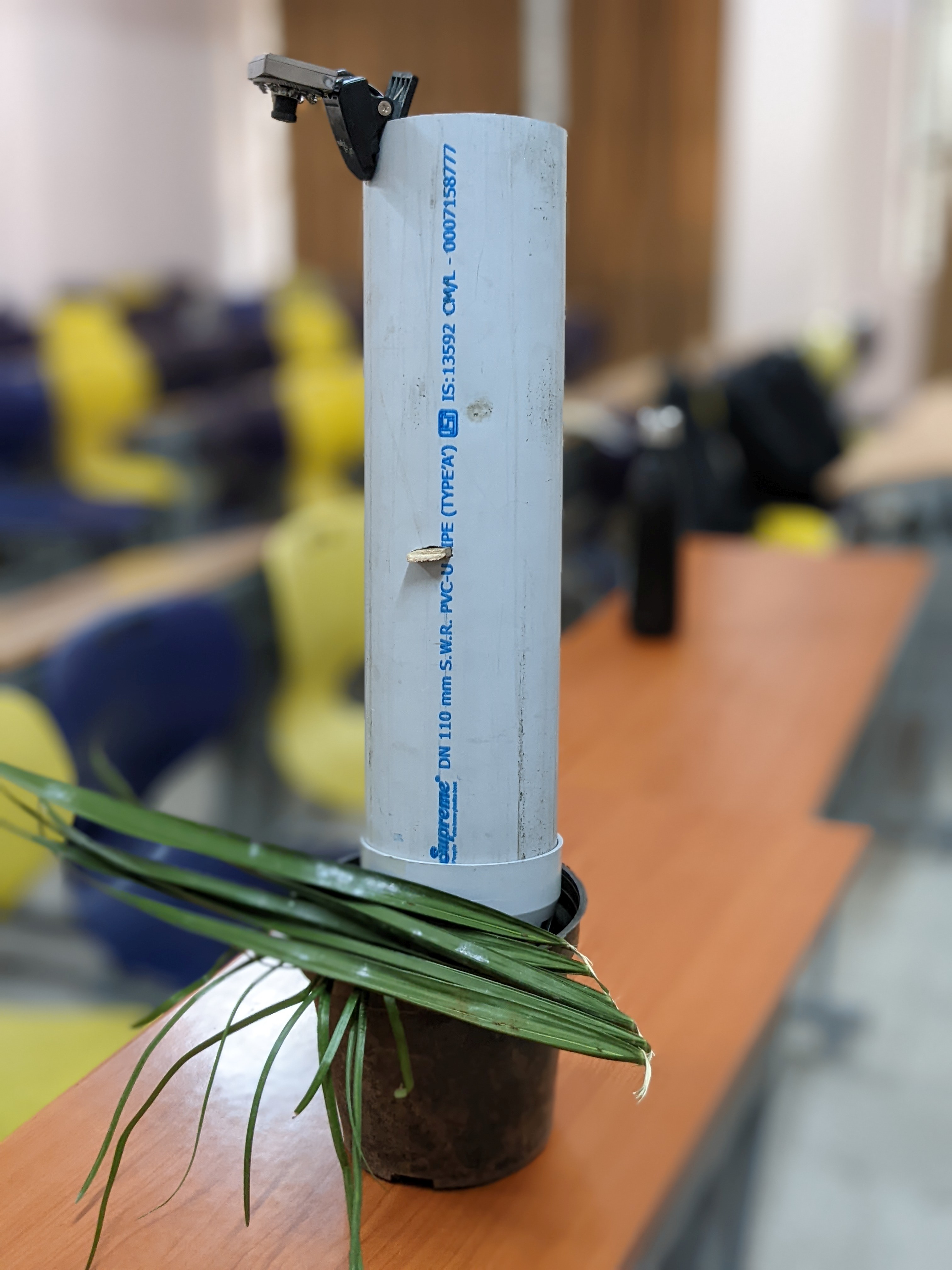
The SFS in its (almost)natural habitat

The SFS
The SFS was originally designed to be a 'stick' but due to space constraints of the DE-10 Nano and all its wiring, the 'stick' did end up being a tad bigger than we had originally planned for.
The original idea was to custom 3D print a PLA stick but the team ended up using a good quality 4" PVC pipe with an internal wooden chassis as research suggested that the dyes of PLA prints result in toxicity of plants and PLA was also considered not safe for plants unless for decoration. It was also stated that PVC is unsafe for plants/crops if used with glue. So, the team came up with a plan to just affix a cowl that slides right on and off without any glue or effort.
The Workflow and the complete system architecture
.png)
Workflow
.png)
System Architecture
1) The Workflow illustrates the raw sensor and image data that flows to the DE-10 Nano that is processed and then sent to Azure which later either notifies the farmer using SMS or notification on a smartphone
2) The system architecture illustrates the complete system architecture clearly illustrating different Hardware and Software components of the SFS
8. Conclusion
In this ever-evolving era of technology, our devised solution produces the following effects technologically, economically, biologically, and socially.
Those include:
-
Decreases human intervention thereby reducing stress
-
Real-time detection of all factors like fertility, disease detection, moisture, humidity, and also weather forecasting increases productivity which means higher profits
-
Analysis and prediction based on soil chemical composition for different crops decreases soil erosion and enriches the soil
-
Moisture maintenance system decreases frequent physical visits to fields, especially during harsh weather
-
Real-time updates through SMS etc. increases comfort and better quality of work-life balance
-
Weather-based prediction for effective crop planting helps in identifying the best-suited crop decreases monetary loss and pressure on self
Therefore, we believe the product can help achieve monetary, mental, and social stability which eases the life of a farmer.
Overall, building this project has been absolutely thrilling and we can't wait to improve the SFS and actually help lives!
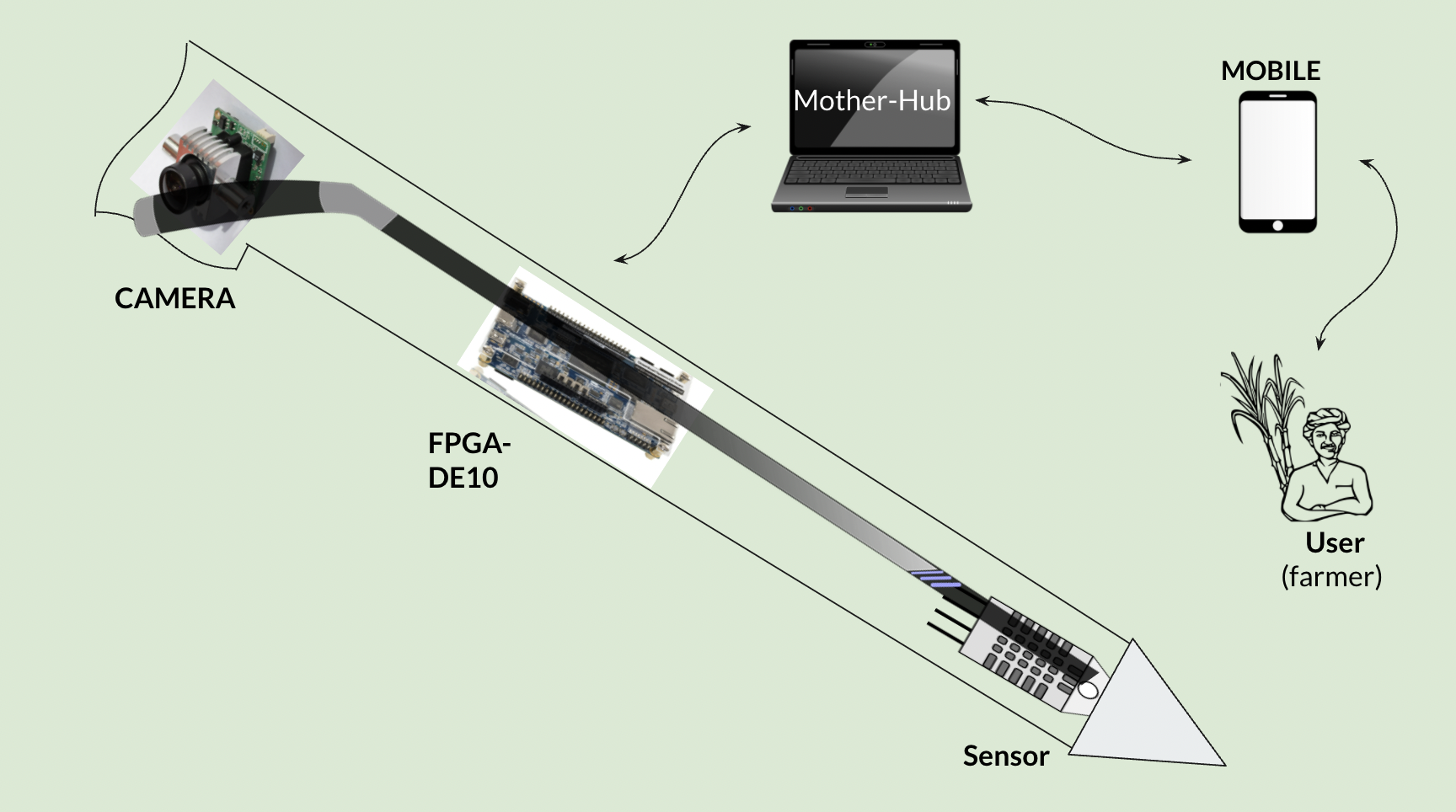
0 Comments
Please login to post a comment.